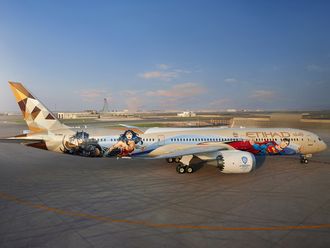
Dubai: Dubai aims to ‘re-engineer the airport process’ at the newly proposed passenger terminal at Al Maktoum International, also known as DWC, according to Dubai Airports CEO Paul Griffiths.
“Our goal with the new airport project, a $32 billion endeavor slated to be operational within the next ten years, is to achieve a seamless, efficient experience,” Griffiths said during a panel discussion at the World Air Transport Summit during the International Air Transport Association (IATA) annual general meeting (AGM) on Tuesday.
He said that many airport designs around the world tend to scale in a way that exacerbates issues like long walking distances and centralised security and immigration checkpoints, which Griffiths defined as the ‘lazy airport operator syndrome.’ This approach creates bottlenecks and inefficiencies, he explained.
“So, if we can actually look at reengineering the entire airport process, eliminate most of the legacy things that exist in airports that have been there for a long, long time. We want to recreate the idea of going from training or sustainable form of transport to the airport to plane in the shortest possible distance and time,” he said, adding it would be a much better experience.
Sustainability-focus
Griffiths said that most sustainable progress will likely occur on the ground, with new personal mobility options that are far eco-friendlier. “The challenge in designing a 21st-century airport is to create flexible infrastructure that can adapt to rapid technological advancements. Here in the UAE, we have ample solar energy to power most of the city,” he said.
“Innovations like storing energy by cooling water and using it at night to cool buildings are already in practice, significantly reducing our carbon footprint,” Griffiths added.
“Instead of focusing solely on the 2050 carbon neutrality target, I prefer to see tangible actions taken today that set us on the right path. We need to prioritize immediate actions that positively impact the future, rather than relying on distant targets that may lack clear plans or justification,” stated Griffiths.
This new airport will have the capacity to handle 260 million passengers when fully developed, with 400 gates. “The first phase aims to accommodate 150 million passengers within the next 10 years, and we're exploring ways to expedite this growth,” Griffiths added.
Growth in tourist numbers
Before COVID, 60 per cent of all travellers through DXB were connecting flights, and 40 per cent were entering the city, explained Griffiths, adding that the government has done an excellent job promoting Dubai as a safe and medically advanced destination, which has flipped the statistics.
“At one point last year, 60 per cent were visiting Dubai, and 40 per cent were in transit. As the city continues to grow, we expect this ratio to stabilize. Interestingly, despite tripling in size over the last 15 years, the proportion of transit passengers has decreased,” he added. This shift highlights the greater economic impact of visitors staying in the city compared to those just passing through, he added.
Kamil Al-Awadhi, Regional Vice President for Africa and the Middle East at IATA, expects passenger traffic in the UAE and Gulf countries to grow by four per cent annually from 2024 to 2030. He attributed this uptrend to the region's long-term vision and infrastructure to accommodate growth, citing the new Al Maktoum Airport announcement for expansion, the opening of a new airport in Kuwait within a year, and upcoming project announcements from Saudi Arabia.












